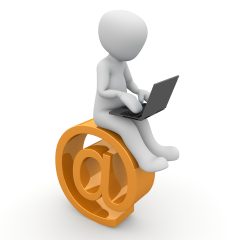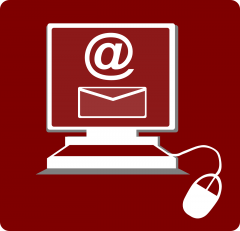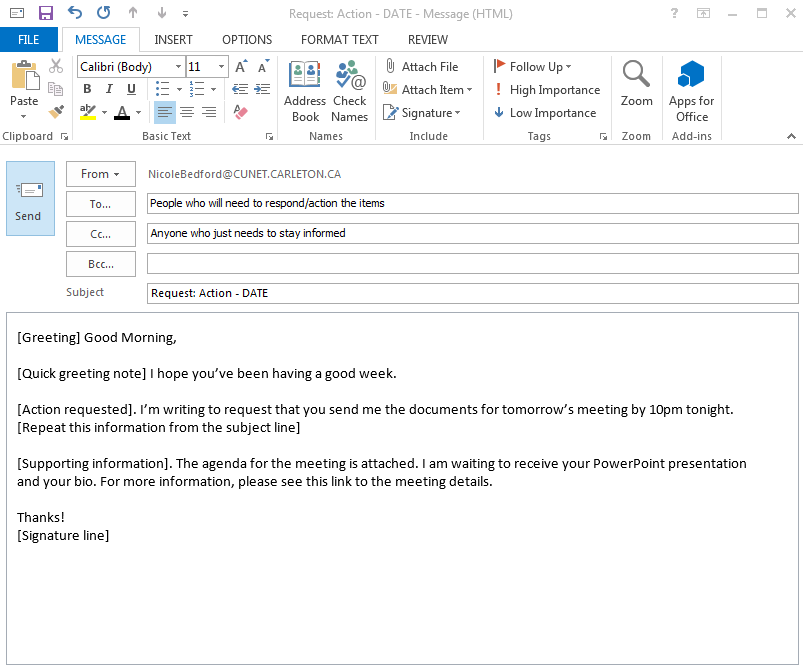by Nicole Bedford, CFICE Project Manager and Communications Coordinator
 In the realm of community-campus engagement, clear communication is vital for maintaining good relationships with all partners involved.
In the realm of community-campus engagement, clear communication is vital for maintaining good relationships with all partners involved.
On average, most people receive between 20 and 80 emails per day. For some, (in particular, busy community and academic partners), this daily average can increase to 100+ emails! This can be an overwhelming amount of information to sift through, especially when the action items or response requirements aren’t very clear.
By following these handy strategies and tips, you can help reduce email confusion and streamline your email communication.
Write a Useful Subject Line
Email subject lines should help the recipient to easily triage priorities.
The best subject lines work like newspaper headings in that they:
- Convey exactly what the email is about;
- State important dates/deadlines; and
- Indicate the response or action required.
For example, if you are planning a meeting and you are distributing meeting documents, you could use the subject line “FYI: Prep documents for June 10th meeting”. This subject line tells the recipient that they don’t need to read this email right away, but that they will need to review the documents before June 10th.
If your email is urgent and you need an immediate decision, you could write “Decision Needed by 4pm August 1: Catering for 10 or 12?”
A Note on Acronyms: Some people recommend the use of acronyms such as FYI (for your information), EOM (end of message), and AR (action required) to help reduce the length of email subject lines. Unless you are confident your recipients will know the acronyms being used, avoid them as they are more likely to cause confusion.
 Think about your recipient
Think about your recipient
Correctly Use the To, Cc, and Bcc fields
The proper use of the To, Cc, and Bcc fields seems to be a mystery for most individuals using email today. Here is how they should be used in order to optimize your email communications:
To: The ‘To’ field should include anyone who needs to respond to the email or complete an action that is mentioned in the email.
Cc: The ‘Cc’ field stands for “carbon copy” (from the days of typewriters). True to it’s name, it should only include individuals who need a copy of the information to stay informed. (This is the FYI field!)
Bcc: The ‘Bcc’ field stands for “blind carbon copy”. Unlike the ‘To’ and ‘Cc’ fields, any email addresses included in the Bcc field will not be visible to the email recipients. That said, the Bcc field should be used with caution lest a Bcc’d individual suddenly replies to an email that no one else knows they received!
The best practice is to never use the Bcc field unless you are sending out a mass communication where you don’t want people to be able to see everyone’s contact information. For example, if you are sending out a newsletter, including your followers’ emails in the Bcc field would be appropriate.
Consider Communications Styles
Everyone communicates differently, so you need to keep this in mind when writing your emails. Some people like a more informal communication style, some like to include lots of detail, and others still are most interested in seeing only the action required. While it’s always best to tailor your emails to the style preferred by your recipient, the following is a basic template for effective emails that can be used for all recipients, regardless of their communications style:
[Click on the image to download the plain text version (PDF)]
By structuring your emails in this manner, you are able to include:
- An amiable introduction (for those with a preference for more informal emails) that leads to
- The direct information or action item (for those who only want the most pertinent information), which is followed by
- Supporting details (for those who like a lot of detail).
Correctly Use “Reply” and “Reply All”
 When replying to an email, make sure that the subject line still pertains to the information in the body of the email. In short: Don’t hit reply and introduce a new topic. If you need to discuss something new, start a new email chain with a subject that pertains to the email’s content. This helps recipients organize their emails and prevents them from losing important information and action requests.
When replying to an email, make sure that the subject line still pertains to the information in the body of the email. In short: Don’t hit reply and introduce a new topic. If you need to discuss something new, start a new email chain with a subject that pertains to the email’s content. This helps recipients organize their emails and prevents them from losing important information and action requests.
Similarly, be careful with your use of ‘Reply All’. Some best practices when using ‘Reply All’ include:
- Only use ‘Reply All’ when responding to an email in which you are included in the ‘To’ field.
- When the ‘To’ and ‘Cc’ fields are used correctly, recipients in the ‘Cc’ field are included to keep them informed, not to engage in the dialogue. If you want to respond to the information, it is best to respond only to the sender of the email, and not to everyone included. Of course, circumstances may vary, so use your own judgement as to when ‘Reply All’ is appropriate.
- When using “Reply All”, remove from the ‘To’ field any recipients to whom your email does not apply.
- If you still want to keep these individuals informed of the conversation, move their emails to the ‘Cc’ field.
- You can also remove recipients from the ‘Cc’ field if they no longer need to be included in the email chain, though this can be a touchy practice. Use your judgement based on your organization’s culture.
Additional Considerations
 Some final tips and pointers for writing the most effective emails possible include:
Some final tips and pointers for writing the most effective emails possible include:
- Know the intention of the email before you write it.
- This includes knowing the specific action you want recipients to take and the deadline by when this action should be completed.
- Keep your emails as simple and brief as possible.
- Be clear about your message and direction.
- Use plain language writing where possible (see our video and handouts on plain language writing).
- Format the emails to enhance readability.
- Use bullets points where possible.
- Use bold, underlining, and highlighting sparingly.
- Only include one subject/action item per email.
- Use the word ‘please’ with caution.
- While the word ‘please’ seems like a good word to include when requesting that a task be completed (e.g. Please send this to me by Friday), it is a passive word that can reduce the impact and importance of your request.
- Don’t forget to include your contact information.
- Note that: The fewer emails you send, the fewer you will receive!
Email writing can seem like an informal and easy process, but for your recipients (and your overloaded inbox), it pays to learn how to craft emails that are clear, concise, and properly directed. By employing even a few of these tips and strategies, you will be able to significantly enhance your email writing abilities.
Happy writing!
